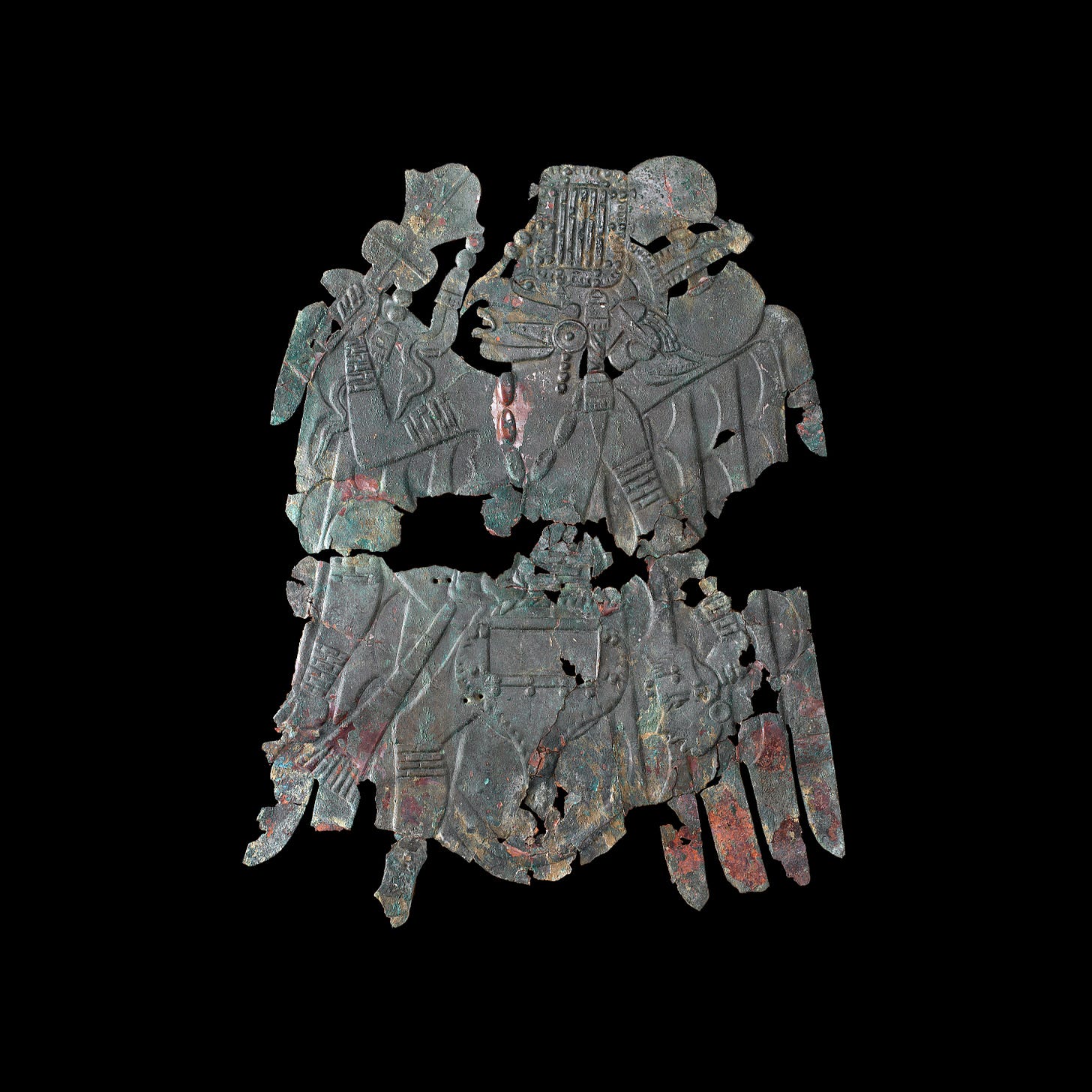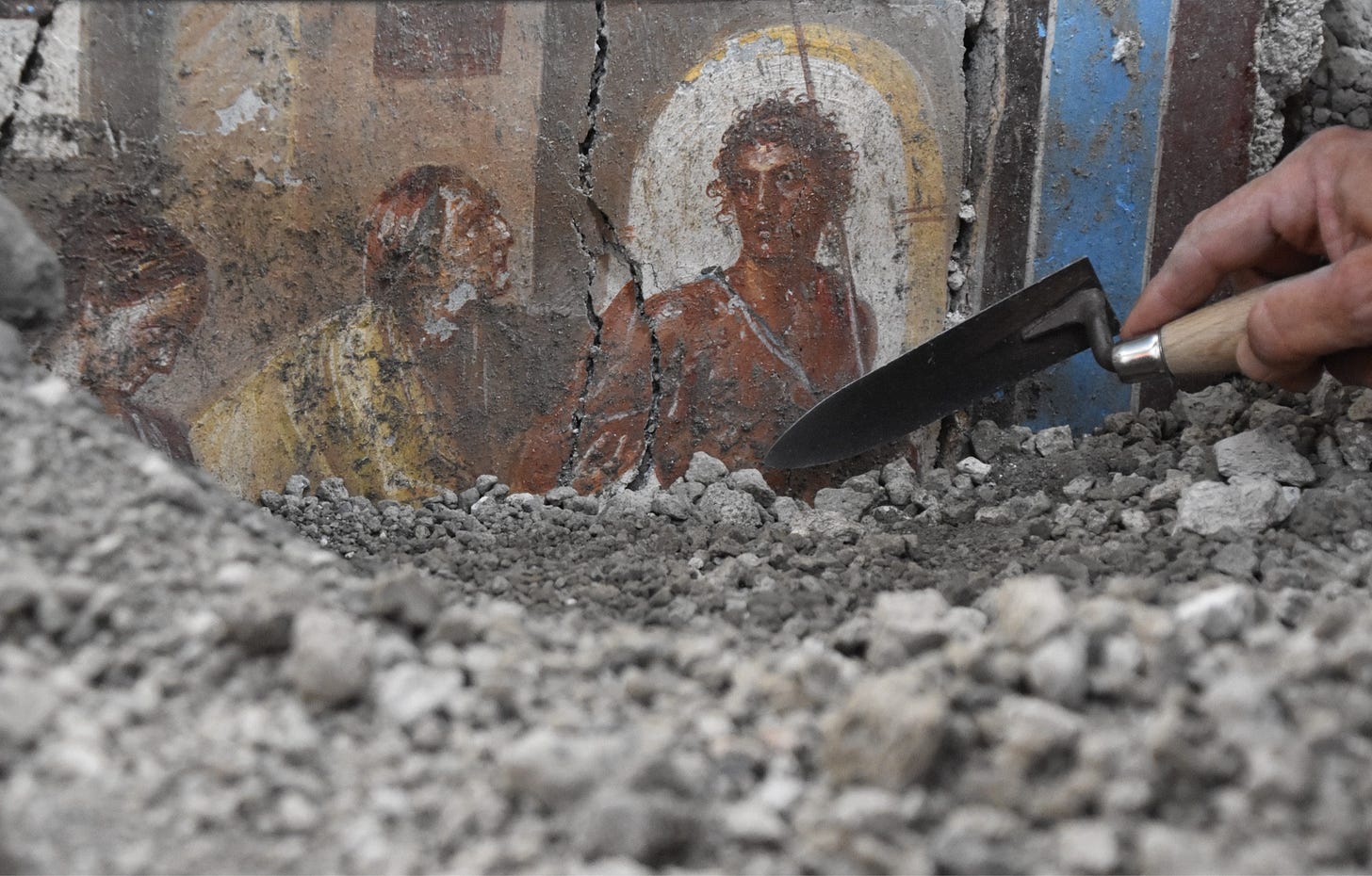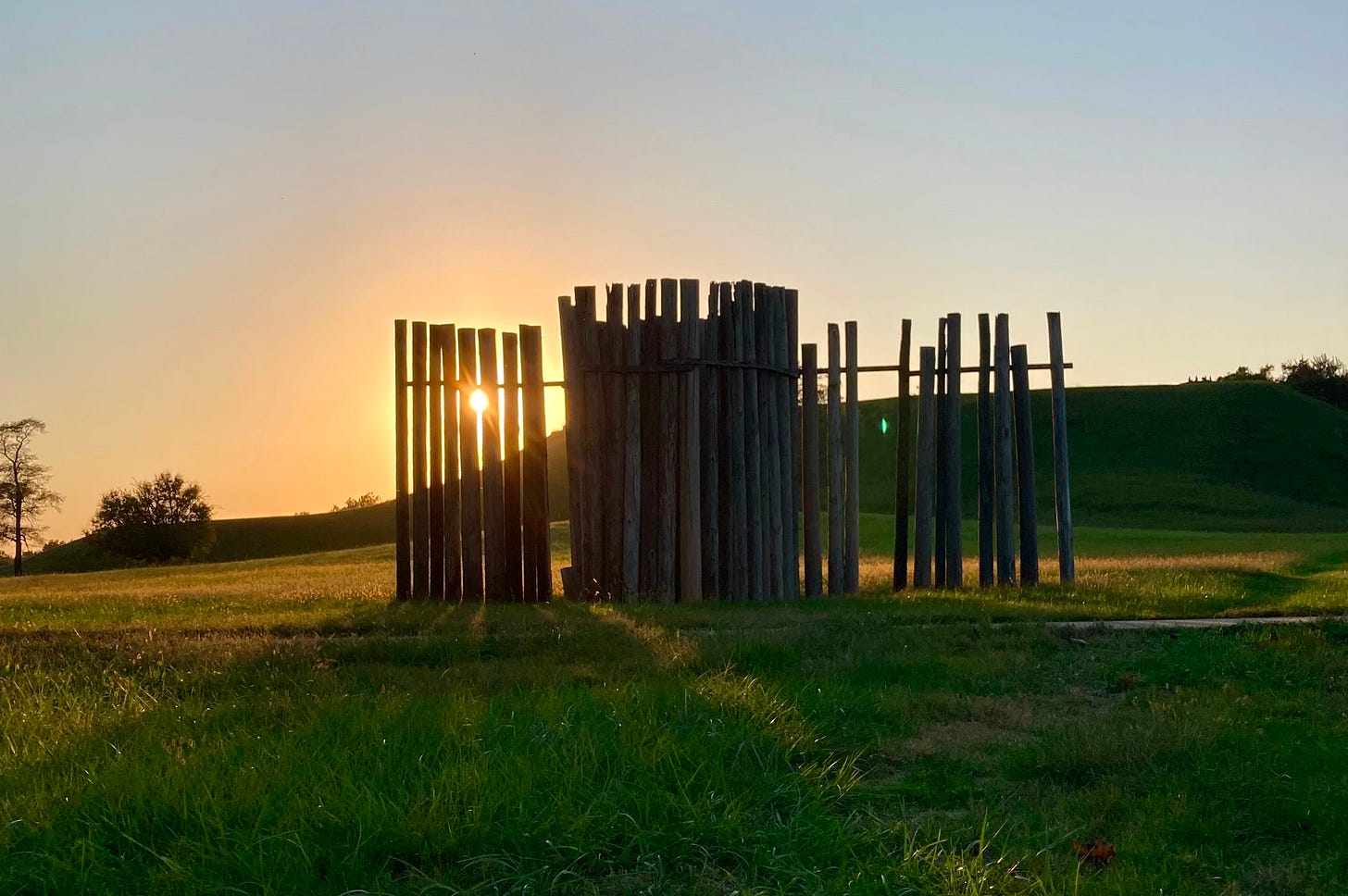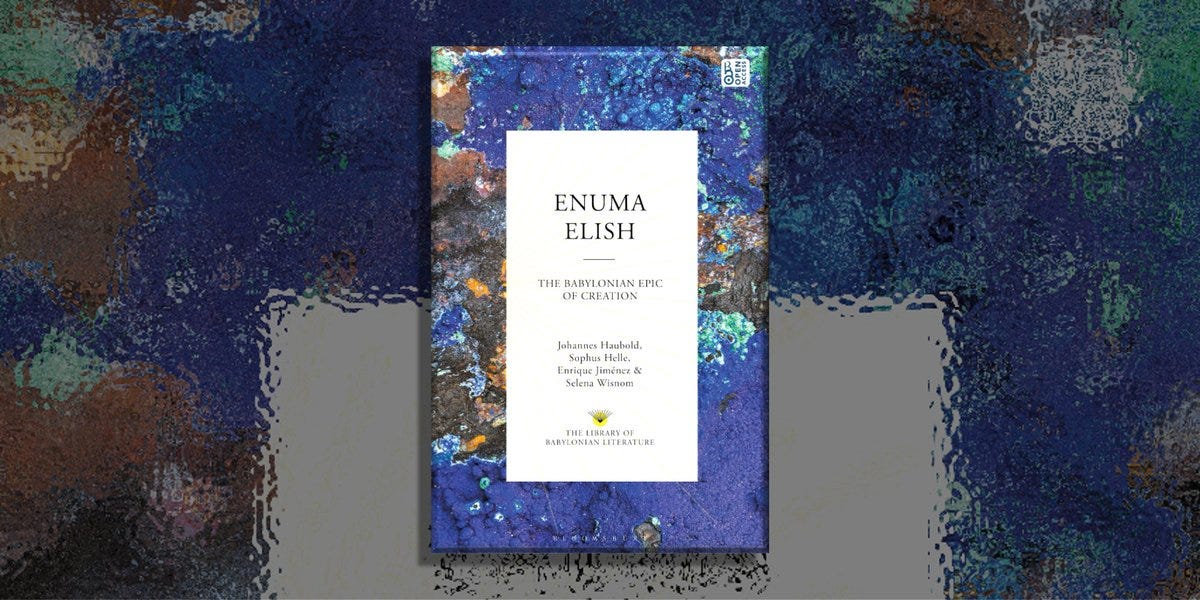Pasts Imperfect (11.7.24)
Cahokia Mounds, a New-to-Us Maya City, the Bombing of Lebanon & More

This week, historian Stephanie Wong discusses her trip to Cahokia Mounds State Historic Site. Then, the recent Israeli attacks on Lebanon, archaeologists using Light Detection and Ranging (LiDAR) technology uncover a new Maya city and ancient sites in Uzbekistan, a review of the British Museum’s new “Silk Roads” exhibit, a digital archaeology special issue, an open access translation of the Enuma Elish is published, new ancient world journals, and much more.
Embracing Cahokia as Part of a Global Premodern History by Stephanie Wong
Because I wasn’t a gunner who took AP World History my first year of high school, my freshman social studies class was called Ancient/Medieval History. My teacher led us through the greatest hits of the premodern world: Egypt, of course. Greece. The Vikings. Mostly what I remember from this class is sitting next to a guy named Jason who laughed when we watched a video of the Fukushima tsunami, and assiduously illuminating my notebook with 5 Gum foil wrappers.
Now it’s 2024, and, as a professional Historian™, I’d like to think that conversations about ancient/medieval history have evolved to become more inclusive. (Anything to keep 14-year-old Stephanie out of boredom.) A few weeks ago, I traveled to Cahokia Mounds in Collinsville, IL to report on a story. And now I want to know more.
Cahokia is a millennium-old site central to Mississippian culture, a civilization made up of several Indigenous communities spanning what is now known as the American Midwest and Southeast. Known for its enormous earthen mounds, it’s considered to be the center of this wide-ranging society. But also, importantly, the site is also sacred to Indigenous tribal nations in the United States today. As someone who presently studies the Americas and has studied Greco-Roman archaeology, I approached this project with curious eyes: why Cahokia, and why now?

We don’t know the original name of the site. Its modern name comes from one of the Indigenous tribes who occupied it—assigned to the place by French colonizers in the early eighteenth century. The tribe is now extinct, and, according to the Oklahoma Historical Society, the community in the 1700s had little to no relation to the premodern inhabitants of the site. Now, however, members of the Osage and Chickasaw Nations, among others, claim Cahokia as a sacred ancestral site.
It doesn’t take much to understand the colonial and imperial implications of archaeology and anthropology. Think of white men with sunburns and pith helmets “discovering” ancient civilizations. Think of centuries of looting and conversations about repatriation. When I was at Cahokia, I thought of my Ancient/Medieval History class as well as the very real, very present present I was observing. How should archaeologists in the year 2024 interact with and share Indigenous history? How can non-archaeologists understand a complicated past that they have never been taught?
Collinsville, IL is proud of its historic site. I was pleasantly surprised to see a diverse array of people using the public space: while hiking Monks Mound, I passed runners, families on picnics, folks walking their dogs. During a brief sojourn downtown, I was caught in the town’s homecoming parade. Strangers chatted me up, knowing immediately that I came from far away, and were effusive in their kindness. One woman rushed into her store, a small business promoting the work of local artists, and pressed a gift in my hand: a fridge magnet emblazoned with the town’s name and an illustration of Monks Mound, and a vinyl sticker depicting the high school’s logo. I took a closer look: the mascot was the “Kahok” — a representation of an Indigenous person, now extinct.
Toni Morrison says, “Canon building is empire building.” I’m writing as a proud Midwesterner, born and raised, and a real-time student of Ancient/Medieval History. It’s my firm belief that we should include Cahokia in the greatest hits of the premodern Americas. (I mean, just look at how big Monks Mound is.) And our duty as people who study the past doesn’t end at arbitrary periodization.
We live in the present moment. Let’s carry history forward.
Global Antiquity and Public Humanities
Israeli forces continue their destruction of cities and towns in Lebanon, including airstrikes on Baalbek and Tyre. At least 70 people have died in the attacks. In Hyperallergic, Sarah E. Bond spoke to ancient religion scholar Laura Nasrallah and Lebanese archaeologist Nelly P. Abboud about the attacks on Lebanon and Gaza, as well as threats to the Roman temples at the ancient site of Heliopolis beside Baalbek.
LiDAR strikes again! Researchers in the Mexican state of Campeche have found a Maya city, which they call Valeriana, after graduate student Luke Auld-Thomas noticed something a little strange about some publicly accessible drone data. And there are Maya structures galore—more than 6,500. How exciting. LiDAR also takes center stage in Central Asia: the mountains of southeastern Uzbekistan yield evidence of urban populations along the Silk Road (second century BCE to the 15th century CE), at a massive site called Tugunbulak.
In the London Review of Books, ancient historian Josephine Quinn discusses the new exhibition at the British Museum, “Silk Roads” (on display until February 23, 2025). The focus is on the period of 500-1000 CE and, as Quinn notes, the exhibition has a number of stunning works that viewers can engage with:
Another showstopper, a plain bolt of silk made in the third or fourth century, was excavated at Loulan in the Xinjiang Uyghur Autonomous Region in the far north-west of modern China. It has a bracing functionality, but it is also fragile: a creased, flattened cylinder, yellow-brown and broken in two. Standard bolts of 12m x 54cm were used for tax payments in Tang China. On routes west they could serve as salary for Chinese soldiers, and as valuable currency.
My (Sarah here) personal favorite listed in the exhibition? The famed silk princess painting (500-599 CE) from Dandan-Uiliq.
The BBC’s Alice Morrison explores Hegra, an ancient site in Saudi Arabia and the second city of ancient Nabataea. Come for the history, stay for the stunning desert landscape.

Next Halloween, prove to your friends that you really know it all, with the help of USC Irish history prof Lisa Bitel. Bitel sets the record straight: Samhain—the ancient Irish pagan holiday—is Irish, while Halloween is not.
Like Christmas, Valentine’s Day and Easter, Halloween eventually became a feast of consumerism. Companies mass-produced costumes, paper decorations and packaged candy. People in Britain and Ireland blamed the Americans for the spread of modern Halloween and its customs. British schools even tried to quash the holiday in the 1990s because of its disorderly and demonic connotations.
Do Americans ruin everything, or do we make it better…??
Speaking of Americans making things better/worse/different, check out this McDonald’s at this ancient Roman archaeological site in Frattocchie, Italy (CW: Human remains):
The newest issue of Reviews in Digital Humanities is out now and it has reviews of four important digital archaeology projects: “The Zamani Research Project, which aims to capture spatial data of heritage sites in Africa to create a permanent digital record of important monuments and their immediate environments; The Giza Project, which assembles information about all the archaeological activity at the most famous site in the world: the Giza Pyramids and surrounding cemeteries and settlements (third millennium BCE to present); Nomisma.org, which provides stable identities for numismatic concepts, such as mints, denominations, and rulers, according to the principles of linked open data; and The al-Thurayya Project, which includes [a] gazetteer and a geospatial model of the early Islamic world.”
Finally, congrats to Johannes Haubold , Sophus Helle, Enrique Jiménez, and Selena Wisnom on the open access publication of their Enuma Elish: The Babylonian Epic of Creation. You can download it for free here. It is part of The Library of Babylonian Literature series from Bloomsbury Press.
New Antiquity Journal Issues (by @YaleClassicsLib / yaleclassicslib.bsky.social)
Acta Archaeologica Vol. 94, No. 2 (2023)
The Classical Journal Vol. 120, No. 1 (2024) NB Debby Sneed, “Ancient Greek and Roman Crip Lit”
Dao Vol. 23, No. 4 (2024)
Digital Scholarship in the Humanities Vol. 39, No. 4 (2024) NB Aengus Ward & Shiyu He, “Medieval reading in the twenty-first century?” NB
Forum Classicum No. 2 (2024) #openaccess
North American journal of Celtic studies Vol. 8, No. 2 (2024) New approaches to medieval Celtic receptions of Roman historiography
Journal of Urban Archaeology Vol. 10 (2024) Situating High-Definition Archaeology in Urban Archaeological Practice
Journal of Ancient Philosophy Vol. 18, No. 2 (2024) #openaccess
Greece & Rome Vol. 71, No. 2 (2024) NB Benjamin Jasnow “Now Art Comes: The Parthenon and Racial Conquest in Kansas City”
Journal of Islamic Philosophy Vol. 15, No. 2 (2024)
Vigiliae Christianae Vol. 78, No. 5 (2024)
Classical Antiquity Vol. 43, No. 2 (2024) NB David Gissen, et al. “An Archaeology of Disability: A Dialogic Essay”
Antiquity Vol. 98, No. 401 (2024) NB Trevor Van Damme & Bartłomiej Lis “The origin of the Protogeometric style in northern Greece and its relevance for the absolute chronology of the Early Iron Age”
Scripta Mediaevalia Vol. 17 No. 2 (2024) #openaccess
Mnemosyne Vol. 77, No. 6 (2024)
Mediaevalia Vol. 45 (2024) Medieval Cultural Heritage, Then and Now
Digital Philology Vol. 13, No. 2 (2024) Fragmentology, Vol. 2
New England Classical Journal Vol. 51 No. 2 (2024) NB Talia Boylan, “Amy Barbour: Biography as Scholarly Self-Fashioning”
Acta Praehistorica et Archaeologica Vol. 53 (2021) #openaccess
Anatolian Studies Vol. 74 (2024)
American Journal of Philology Vol. 145, No. 3 (2024)
International Journal of the Classical Tradition Vol. 34, No. 4 (2024)
Digital Exhibitions, Lectures, and Workshops
On November 22, 2024 at 3:00-4:15pm (EST) join the SAM Webinar on the Trajectory of Ancient Medicine as a Subfield: You’re warmly invited to participate in a webinar round table discussion with Vivian Nutton (UCL), Lesley Dean-Jones (UT Austin), and Ralph Rosen (UPenn) to discuss how ancient medicine has developed as a subfield through the course of their richly productive careers. From different educational backgrounds and research expertises, our panelists will trace the reception of their areas of interest in classics and history departments and the wider university context. Aileen Das (SAM President; UM Classics) and Anna Freidin (UM History) will facilitate the event, which also serves to celebrate the accomplishments of these recent retirees. Register in advance here.










Thank you, interesting as always. Were the cahokians giants? Seems they, big as they were, just disappeared,, leaving only some dna here and there?
Thank you, interesting as always. Were the cahokians giants? Seems they, big as they were, just disappeared,, leaving only some dna here and there?